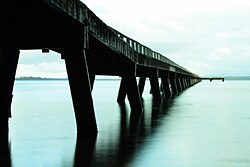Tahawai
Tahawai | |
|---|---|
Rural community | |
 Kauri Point Jetty | |
 | |
| Coordinates: 37°31′08″S 175°55′12″E / 37.519°S 175.920°E | |
| Country | New Zealand |
| Region | Bay of Plenty |
| Territorial authority | Western Bay of Plenty District |
| Ward | Katikati-Waihi Beach Ward |
| Community | Katikati Community |
| Electorates | |
| Government | |
| • Territorial Authority | Western Bay of Plenty District Council |
| • Regional council | Bay of Plenty Regional Council |
| Area | |
| • Total | 82.11 km2 (31.70 sq mi) |
| Population (June 2023)[2] | |
| • Total | 2,030 |
| • Density | 25/km2 (64/sq mi) |
| Postcode(s) | 3170 |
Tahawai is a rural community in the Western Bay of Plenty District and Bay of Plenty Region of New Zealand's North Island. State Highway 2 runs through it. A peninsula on the eastern side of the area in Tauranga Harbour ends with the small settlements of Tuapiro Point,[3] Ongare Point and Kauri Point, with a walkway between the latter two.[4][5] A smaller peninsula further north ends at Tanners Point.[6]
Demographics
Tahawai statistical area, which includes Tanners Point, Ongare Point and Kauri Point, covers 82.11 km2 (31.70 sq mi)[1] and had an estimated population of 2,030 as of June 2023,[2] with a population density of 25 people per km2.
| Year | Pop. | ±% p.a. |
|---|---|---|
| 2006 | 1,743 | — |
| 2013 | 1,707 | −0.30% |
| 2018 | 1,833 | +1.43% |
| Source: [7] | ||
Tahawai had a population of 1,833 at the
Ethnicities were 90.5% European/Pākehā, 10.6% Māori, 1.8% Pacific peoples, 3.6% Asian, and 1.3% other ethnicities. People may identify with more than one ethnicity.
The percentage of people born overseas was 18.7, compared with 27.1% nationally.
Although some people chose not to answer the census's question about religious affiliation, 55.6% had no religion, 30.6% were Christian, 1.1% had Māori religious beliefs, 0.5% were Hindu, 0.2% were Muslim, 0.5% were Buddhist and 2.1% had other religions.
Of those at least 15 years old, 267 (16.7%) people had a bachelor's or higher degree, and 297 (18.6%) people had no formal qualifications. The median income was $30,900, compared with $31,800 nationally. 306 people (19.1%) earned over $70,000 compared to 17.2% nationally. The employment status of those at least 15 was that 726 (45.4%) people were employed full-time, 279 (17.4%) were part-time, and 39 (2.4%) were unemployed.[7]
References
- ^ a b "ArcGIS Web Application". statsnz.maps.arcgis.com. Retrieved 25 January 2024.
- ^ a b "Population estimate tables - NZ.Stat". Statistics New Zealand. Retrieved 25 October 2023.
- ^ "Tuapiro Point". Western Bay of Plenty District Council. Retrieved 27 November 2020.
- ^ "Kauri Point – Ongare Point". 3 March 2016.
- ^ "Kauri Point Historic Reserve". Western Bay of Plenty District Council. Retrieved 27 November 2020.
- ^ "Tanners Point". Western Bay of Plenty District Council. Retrieved 27 November 2020.
- ^ a b "Statistical area 1 dataset for 2018 Census". Statistics New Zealand. March 2020. Tahawai (190300). 2018 Census place summary: Tahawai
